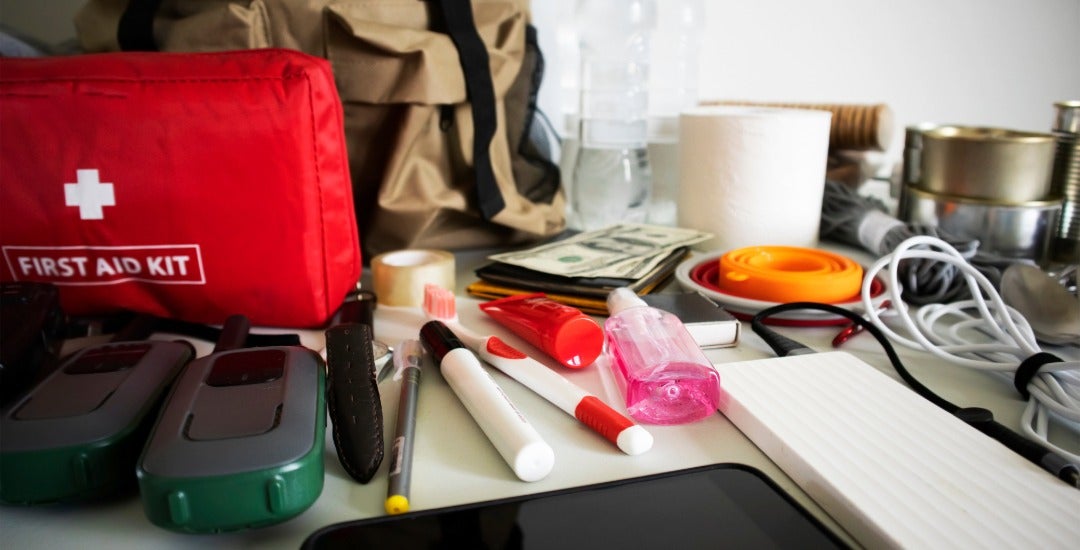A Kinder Institute for Urban Research survey shows Houstonians generally prepare well for disasters yet trail the national average in two key categories: assembling emergency supplies and making a household family emergency plan.
The findings are based on responses from over 5,000 Harris County residents surveyed in mid-2024 — with some collected in the weeks after Hurricane Beryl — and a national survey conducted in 2023 by the Federal Emergency Management Agency. Both surveys asked whether participants accomplished 10 tasks related to storm preparation.
With the six-month hurricane season halfway over, two leaders of the Houston-based disaster recovery nonprofit West Street Recovery — Andrew Barley, co-director of rebuild efforts and voter engagement, and David Espinoza, co-director of community organizing — identified how residents and civic leaders can get better equipped for the region’s next natural disaster.
Power outage necessities
Even after floods, hurricanes, freezes and a stray derecho, Houstonians don’t stock up particularly well for storms. Nationally, 48% of households keep their emergency supplies up to date, compared to 35% in Harris County, according to the surveys.
Espinoza recommended that Houstonians prioritize a five- to 10-day supply of nonperishable food and water, proper-sized life jackets, flashlights or lanterns for signaling to emergency rescue personnel, and small backup power sources for technology.
“To keep phones charged, another power supply is helpful. It doesn’t have to be a large battery,” Espinoza said. “Just enough to communicate with people outside. Having any kind of radio is also important to be up to date on the news, or just in case you need to evacuate.”
Barley added that people should carry an object that can break a window and something to plug plumbing issues.
Espinoza said households in West Street Recovery’s service area in northeast Houston are typically more concerned about affording basic expenses than preparing to ride out a disaster.
West Street Recovery can distribute or lend supplies to its community members in advance of a storm. The 211 Texas/United Way helpline can also help connect residents to aid organizations and resources in their area.
A lack of contingency plans
Most Houstonians also haven’t thought ahead much about what to do when disaster strikes.
About 42% of Harris County residents know evacuation routes, while 32% make a household family emergency plan and 16% practice emergency drills.
Harris County’s Office of Emergency Management, the Houston-Galveston Area Council, Houston TranStar and other agencies have evacuation routes and zones available online.
While needs vary by household, most family emergency plans include a designated meeting place, contacts outside of the disaster area, emergency belongings, food and supplies, and any accommodations for disabled individuals and pets.
Espinoza said in lieu of a comprehensive evacuation plan, West Street Recovery tries to keep residents informed of their closest fire stations, hospitals and other resources through text messaging apps.
“People should know what the routes are to get there, and which routes are flooded normally,” he said. “We try to also train people in first aid, just in case they need to know how to take care of themselves or their neighbors.”
Areas of improvement
After Hurricane Beryl, Kinder Institute researchers found that about 68% of residents believed their household was moderately, very or extremely well-prepared, and 63% thought the same of their neighbors.
While residents bear responsibility for their storm preparations, local government and nonprofit leaders can still do more to help.
Espinoza said local officials can increase disaster awareness by communicating more to non-English speakers through multiple channels across Houston.
“People need fluent interpreters, because translation apps or AI can make mistakes,” Espinoza said. “The city and the county governments have been doing better in this area, but the major point is to try. Know the demographics and languages of the region, and try to reach out to as many people as possible.”
In a report on their survey findings, Kinder Institute Research Analyst Anna Glanzer DeLisi and Houston Population Research Center Director Dan Potter concluded the public and private sectors play a pivotal role in the region’s disaster readiness.
“Contributions from utility companies and government agencies at a systems level are also necessary to make local and regional infrastructure more resilient,” the report said.
“Being without electricity in the middle of Houston’s summer heat (following Beryl) led to medical emergencies, food spoilage, and a feeling by many residents that local leaders and utility companies had not adequately prepared for the storm.”


